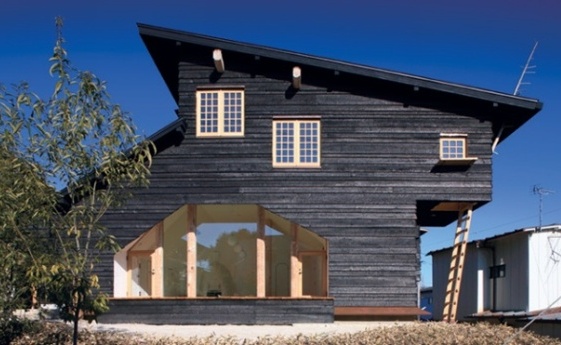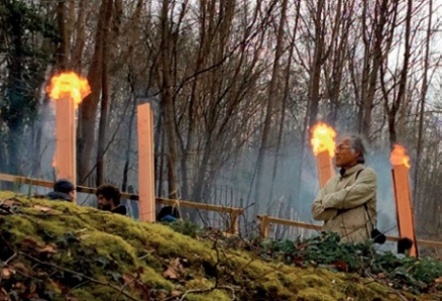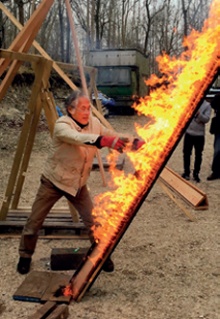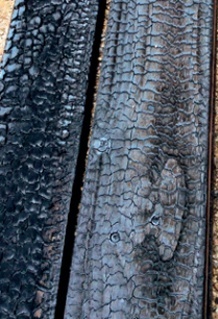Yakisugi Charred Timber
An Ancient Technique in New Hands
Diana Rowsell
 |
|
| Yakisugi cladding on a house designed by Terunobu Fujimori in Utsunomiya, Japan (Photo: Dana Buntrock, Flickr) |
Timber cladding is a traditional feature of the historic environment and today it is a popular finish for new developments and extensions.
Although timbers such as oak and sweet chestnut might be used without any preservative, in many areas black-stained softwoods are a key element of the local vernacular due to the traditional use of coal- and pine-tar resins to preserve exterior cladding.
In the southwest of Japan, however, the traditional preservative technique is wood charring, known as Yakisugi. A similar technique is used in the Swiss Alps where timber chalets last for generations, and charring is a well-known method of preserving wood in many countries and cultures around the world. It is sometimes used on the ends of fence posts to slow down rotting in the ground and on timbers that are joined together with metal elements.
Charring is arguably the oldest method of preserving timber known to man. Since it involves no chemicals, it also has minimal impact on the environment, making it highly sustainable.
YAKISUGI AT THE WEALD & DOWNLAND LIVING MUSEUM
In October 2015 Kingston University tutors Takeshi Hayatsu and Simon Jones visited the Weald & Downland Living Museum with 15 postgraduate architecture students to begin an investigation into architectural materials and building crafts. At the end of that month the students travelled to Japan to explore alternative approaches to building crafts by visiting a number of buildings designed by the contemporary Japanese architect and architectural historian Professor Terunobu Fujimori in his hometown of Nagano. This is a region surrounded by mountains and agricultural land, next to the ancient Shinto shrine complex Suwa Taisha. It is a highly charged place, because the Suwa Taisha shrine is one of Japan’s oldest. In the mountains and in the fields sacred territories are marked by four standing wooden poles which symbolise the presence of gods.
The influence of place is clearly evident in Fujimori’s idiosyncratic work, in which timber plays a central role. In March 2016 Fujimori visited Kingston University as part of a week-long workshop project supported by the Daiwa Anglo-Japanese Foundation. He discussed his approach to design, explaining that he tried to avoid referencing traditional Japanese architecture in his work. Instead his work is often strangely reminiscent of prehistoric monuments and he favours materials that are treated primitively and sourced naturally to clad the exposed surfaces of his buildings.
 |
||
| Professor Fujimori oversees the charring process | ||
 |
 |
|
| Above left: a bundle of burning planks is tipped over to be extinguished. Another triangular bundle can be seen in the background ready for charring. Above right: the douglas fir planks after charring. | ||
Yakisugi cladding is one of Fujimori’s trademark materials. The charring technique makes the cladding planks naturally resistant to damage from moisture, repels insects and prevents fungal decay.
In March 2016, the Kingston students visited the Weald & Downland Living Museum again, this time with Professor Fujimori as the special guest, for a day-long event exploring elements of traditional timber construction in the UK and Japan. The aim of the event was to exchange practical skills through demonstrations of Yakisugi timber treatment and sweet chestnut shingle making.
Shingle-making was demonstrated by 81-year-old Peter Harknett, who is the oldest working steeplejack in the UK. It is a simple method to understand, but much harder to master. The log splits where it wants to split, following the direction of its grain. With experience it becomes easier to predict how the material will behave and a few of the students achieved an acceptable shingle or two.
Yakisugi making was demonstrated by 71-year-old Professor Fujimori. Three-metre long Douglas fir planks were bound together with wire to create triangular chimneys and a ball of newspaper was lit at the base and pushed up inside. As the fire caught the inside faces of the triangulated planks, the intense flames produced a thick layer of charcoal.
Fujimori opened up the corners of the bundles, carefully controlling the flames and ensuring even charring of the plank surfaces. The professor listened to the fire, placing his ear against the back of the burning timber. When he decided they were ready, he wrapped his arms around the burning bundles and lifted them up off their bases, laid them on the ground and then opened them up to extinguish the flames.
Describing the traditional timber construction day, Kingston University course leader Takeshi Hayatsu said ‘These two cladding materials are defined by their creators – both men demonstrated skills learned over years of experience and reminded us of the wisdom of old age and the importance of learning from history, the passing down of craft knowledge from generation to generation’.
Yakisugi has a powerful resonance in the context of modern conservation philosophy and practice. Recent building conservation research, much of it archival, has not only increased our understanding of building materials, how they work, and their efficiency and durability, but has also led to the rediscovery of some traditional materials and methods.
Seeing young students taking part in such an old method was exciting and refreshing. The 30 Yakisugi planks made at the museum have since been used to clad a pavilion which the Kingston University students built as their final course project. Sourcing the timber for the Yakisugi planks locally to the museum also reduced the project’s carbon footprint, helping to meet the project’s objective of minimising environmental impact. The completed pavilion was displayed in the garden of Dorich House Museum in South West London in June and July 2016 as part of the London Festival of Architecture.



